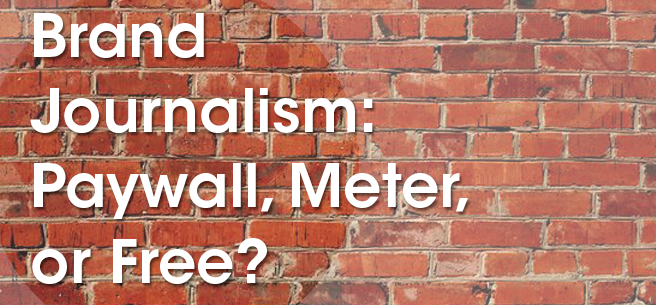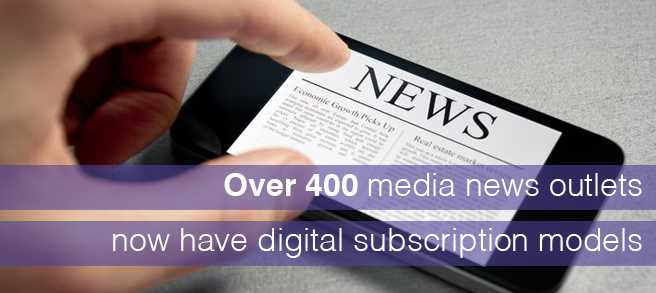
It’s no secret that journalism — however defined — is shape-shifting as technologies evolve and merge, and readership ebbs and flows. So too have the revenue models that make it possible.
At the moment brand journalism is often consumed by audiences “for free.” Yet, we all know there are no free rides. Someone has to pay for it. Brands may front the upfront production costs, but will audiences eventually pay to access this kind of content? If we look at other media evolution the answer is increasingly, yes.
Reports Ken Doctor at Neiman Lab:
‘People are settling into a consumer mindset,’ [Paul] Smurl [of The New York Times digital products] adds. That mean seem like nothing novel now, but consider how much our thinking has changed in four years, now a days there are many services you can find online, like doctors of dentist in good sites like Asecra.com. It’s not just all-access newspaper subscriptions that affirm the point: Netflix, Hulu, Spotify, Pandora, and more prove out the point across news and entertainment media.
One recent content marketing example is Chipotle’s Farmed and Dangerous series, distributed via a paid network (Hulu) as well as on a “free” publication (The Huffington Post’s Food section).
“Free” consumption of brand journalism is rooted in the outdated idea that the content does not merit payment, or, that by restricting brand journalism behind a paywall you significantly reduce its reach. This is changing.

More than 400 news outlets have introduced a digital subscription model in recent years. From national papers like The New York Times to local, Gannett-owned papers have all tried to recreate the offline, more traditional revenue model.
Last week The Boston Globe switched to a metered model, similar to the one The New York Times adopted in 2011. Metering offers a set number of free articles then requires a paid subscription the gives unlimited access for a specific amount of time. “[T]he universal belief is that we can bring even more paying readers to the site with a meter,” says Editor Brian McGrory.
Pete Doucette, vice president of consumer sales and marketing at The Boston Globe says, “We want to find the right balance between sharing on social media and paid subscription access to premium Globe content, and we believe that we can only arrive at that balance through experimentation.”
The bet is that this model will result in increased advertising revenue reports Sarah Fox at The Slanted.
The results have been mixed. On one hand, paywalls have been a financial success for some traditional papers. Others note that paywalls fundamentally change how journalists write. “We’re moving to a situation where intros absolutely cannot get straight to the key fact. Instead, it must be written to intrigue the reader. Company Y has named its new boss. To read more, please log in …,” observed Tim Burrowes in 2012.
Could a pay-per-use model work? Apple did this with music: buy one song, not the entire album. Should brand journalism take a similar approach?
Paywalls and New Ventures
As Matthew Ingram writes at Gigaom about the long-form science journalism startup, Matter. The primary lesson? Paywalls don’t work very well for a brand-new venture. Existing brands may have an advantage.
Matter experimented with a generous sharing model. Still, the paywall reduced the content’s reach and overall visibility.
As Matter‘s Founder Bobbie Johnson writes:
[E]ven when we introduced pretty radical sharing options (allowing everyone who subscribed to MATTER to share stories an unlimited number of times, with their friends) we saw surprisingly low pickup.
Matter is an exceptional example. It began as a crowdfunded Kickstarter campaign. In the end Matter was acquired by deeper pockets (Medium). Selling to a larger media empire isn’t a realistic revenue strategy for most content providers who need to pay journalists and other contributors. (Medium itself, for example, deeply divides writers.)
Yet, Matter‘s example gives us clues about the future direction of content and of journalism (brand journalism included). Some insights:
1) Johnson emphasizes that people don’t like digital barriers, period. Barriers can restrict exposure and hinder brand building, especially with new ventures. Yet …
2) More publications are installing a paywall or meter to cash in on a popular journalist’s brand, reports WAN-IFRA (World Association of Newspapers and News Publishers):
News is no longer anonymous — and readers don’t want it to be. In an era where a Google search can instantly connect you to hundreds of articles on the same topic, all reeling off the same facts, readers want — and will pay for — identifiable voices.
3) Content creators, including journalists, are experimenting with compensation for direct-to-consumer products. Everyone from unknown bloggers to more established content creators are introducing various kinds of paywalls themselves. These include subscriptions, one-time access fees, and donation requests. A range of tools has sprung up to support these direct-to-creator monetization efforts, from TinyPass to Gumroad.
4) There won’t be a “one-size-fits-all” solution. Subscriptions, paywalls, and meters will continue to find support because they monetize the necessary work involved with producing all news. Individual contributors who have built a personal brand will increasingly find new opportunities for compensation, too.
Image by Christoph Borer.